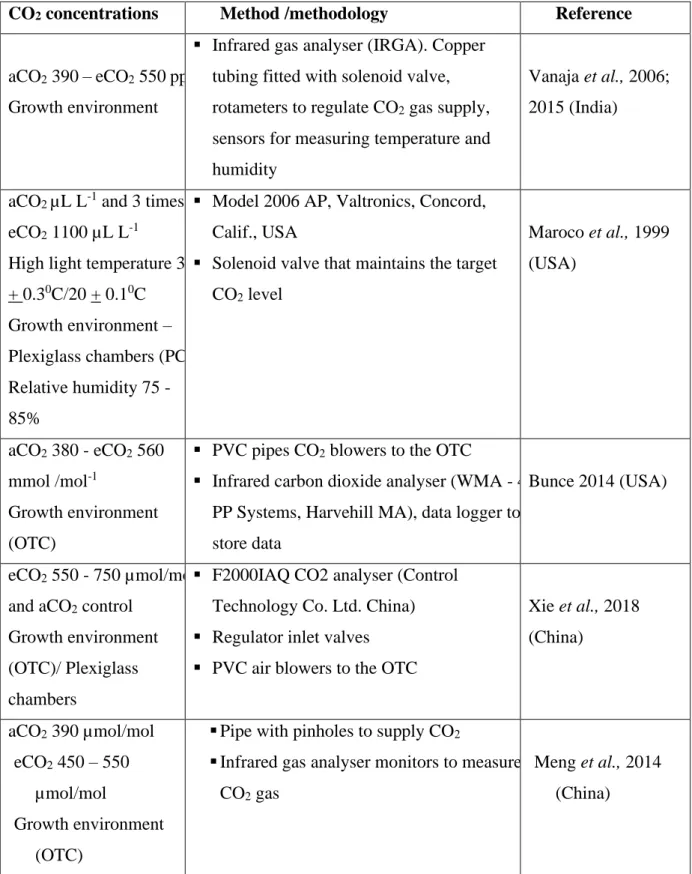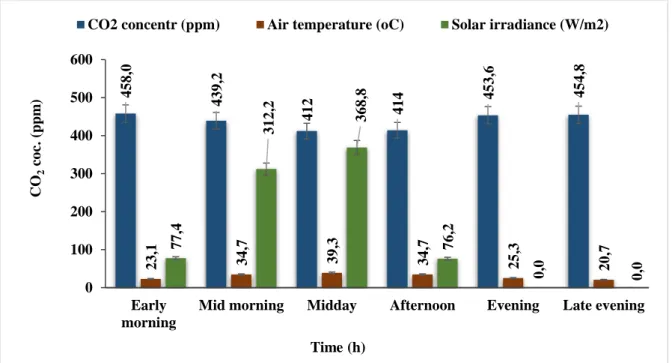I freely grant the copyright of the dissertation in favor of the University of KwaZulu-Natal. Sweet corn (Zea mays L. var. saccharata) is one of the world's most consumed crops in the world and is available in several forms, as fresh corn on the cob and as a canned food (baby corn and kernels).
Introduction
In the 1970s, plant scientists attempted to analyze the impact of atmospheric CO2 concentrations on plant development (Fleisher et al., 2011). Several authors (Kimball, 1983; Lonbg et al., 2004) reported that the impact of eCO2 is related to an increase in the yield of various crops.
Origin and botanical description and domestication of sweetcorn (Zea mays L. var
However, there is little information on the impact that eCO2 has on the nutritional quality of vegetables (Gruda, 2005; Moretti et al., 2010). Only little information seems available on the effect of climate change in African countries on the effect of eCO2 on crop production.
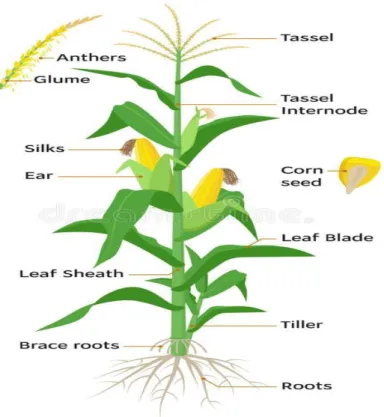
Uses of maize (green and dry grain)
Sweet corn has even been commercially processed into canned and frozen mixed with other plant foods (Pollak and White, 1995). If used in the canning process, the sweet corn is harvested mechanically, so the kernels are cut off the ear, canned, and heat treated for canning (Henry and Kettlewell, 2012).
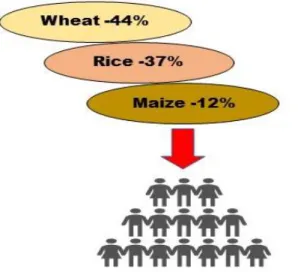
Maize botanical classification
Red colored maize is identified as the sweeter cultivar because of the red color which is probably thoroughly mixed with the rest of the crop (Johannessen et al., 2018). Its diversity is due to human and natural changes to the species that have led to various types of corn.
Maize enhancement for nutritional quality
Maize has been targeted for biofortification, as it is one of the six most consumed staple foods, therefore, drastic measures had to be taken to improve with provitamin A (carotenoids) through conventional agricultural techniques as part of an international effort to combat the vitamin. A deficiency (VAD) (Tanumihardjo, 2008; HarvestPlus Brief, 2006). Due to health incidents, maize has been improved to combat low crop yield (Salem and El-Gizawy, 2012) through applications of fertilizers containing trace elements especially Cu, Fe, Mn and Zn through simple application of fertilizers. , which was found to positively affect food quality (Gupta et al., 2008).
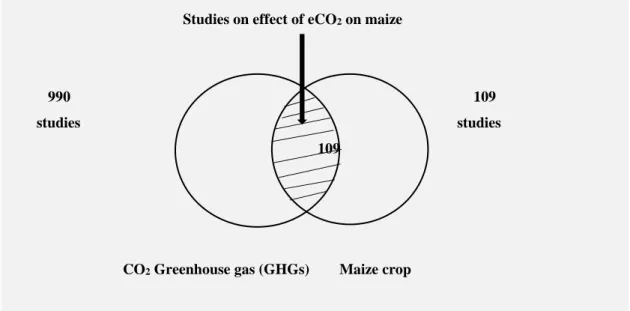
Influence of eCO 2 enrichment on vegetables and crops and their response to eCO 2
- Effects of eCO 2 concentrations on plants enriched with nitrogen
- Effects of eCO 2 on germination, growth, and flowering
- Effects of eCO 2 enrichment on leaf colour and size
- Effects of eCO 2 enrichment and photosynthesis
- Impact that eCO 2 has on plant biomass and yield
The consequences of climate change, especially for vegetables grown in greenhouses, seem difficult to predict due to the large number of conceivable scenarios (Bisbis et al., 2018). As CO2 concentrations persist, slight closure of stomata due to eCO2 should not interfere with the rate of photosynthesis in maize and other C4 plants (Sage, 1999); hence maize growth rate is likely to be positively influenced by CO2 enrichment (Vodnik et al., 2005).
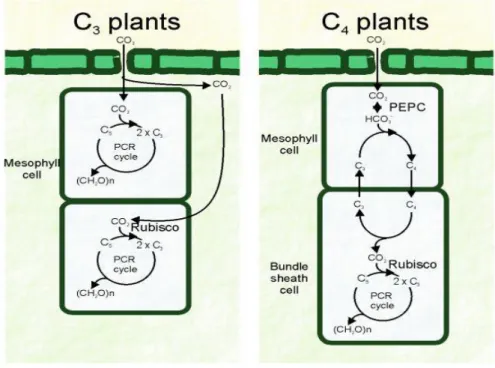
Postharvest phytochemical parameters of maize grown under eCO 2
- Impacts of eCO 2 on kernel carotenoid, sugars, and acidity concentration
- Impacts of eCO 2 on starch and protein (amino acids) concentration
- Impacts of eCO 2 on mineral concentration
Moreover, an increase in carbon availability is likely to lead to an increase in the supply of defense (antioxidant) molecules and is often held largely responsible for better protection against oxidative damage under eCO2 conditions (antioxidant idea) (AbdElgawad et al., 2016). Starch is the major storage carbohydrate in most plants, and its concentration is positively enhanced in plants grown under eCO2 conditions (Araujo et al., 2008).
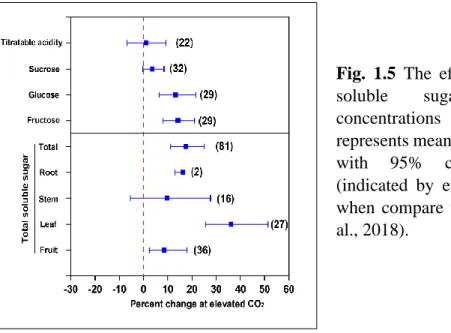
Summary and conclusions
Maize Growth Response to Elevated CO2 Varies with Amount of Nitrogen Applied American Journal of Plant Sciences. The effects of elevated CO2 on seed production and seedling recruitment in a sheep-grazed pasture. Effect of elevated CO2 and temperature on the oxidative stress response to drought in Lolium perenne L.
Effects of elevated CO2 concentrations on growth and yield of eight vegetable species in a cool climate. Interspecific variation in plant growth response to elevated CO2: A search for functional types. Variation in growth and yield response of maize genotypes to elevated CO2 concentration. Advances in Plant and Agricultural Research.
- Introduction
- Materials and methods
- Growing conditions and plant material
- Results
- Assimilation response of sweetcorn to aCO 2 and eCO 2 concentrations at bottom height
- Response of maize plants to eCO 2 during cooler and hot days
- Response of maize plants to aCO 2 in hot and cooler days
- Assimilation response of maize plants grown under eCO2 concentration in glasshouse
- Elevated CO 2 at height 50 cm below CO 2 mycelium bags
- Elevated CO 2 at height 100 cm below CO 2 mycelium bags
- Elevated CO 2 at height 150 cm below CO 2 mycelium bags
- Conclusion
Elevated CO2 was produced in a greenhouse using CO2 mycelium generator bags. It is clear that a significant contrast is observed in aCO2 assimilation during hot and cold days in the presence of lower air temperature and solar radiation. 68 plants, sweet corn exhibits a positive response to CO2 assimilation in the presence of higher temperature and solar radiation (Ghannoum et al., 2000).
The data shows that in the afternoon the CO2 concentration is The amount of eCO2 assimilated between early morning and mid-morning was 62 ppm, indicating a significant decrease in CO2 concentration. Meanwhile, a slight build-up of eCO2 was observed in the afternoon as sweet corn plants photosynthesized due to the drop in temperature and solar radiation.

- Introduction
- Materials and methods
- Growing conditions and plant material
- Results
- Discussion
- Conclusion
Large, rapid changes in climate result from the accumulation of greenhouse gases (GHGs) in the Earth's atmosphere; this has been and is aligned with an increase in global temperature, changing global precipitation patterns (Forster et al., 2007; Vanaja et al., 2015). Cell elongation was probably limited due to the relatively low temperatures in the greenhouse during the winter season (Wolfe, 1991); this may have affected plant height (180.9 under eCO2 and 123.4 under aCO2), visible as relatively short maize plants in both the eCO2 and aCO2 greenhouses. Similarly, in the current study, the days to reaching a certain phenological milestone (days to tasselling, anthesis, and silking) were shortened.
Total biomass from data recorded in the present study was greatly improved, except for fruit yield (Table 3.3), possibly due to plants being susceptible to a colder growing season with lower temperatures (Waqas et al., 2021). Contribution of Working Group 1 to the Fourth Assessment Report of the Intergovernmental Panel on Climate Change. Variation in k(cat) of Rubisco in C3 and C4 plants and some implications for photosynthetic performance at high and low temperature Journal of Experimental Botany.
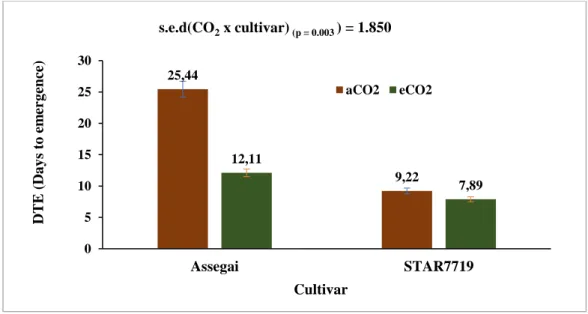
- Introduction
- Materials and Methods
- Laboratory analysis
- Determination of carotenoid and chlorophyll concentrations in sweetcorn
- Results
- Discussion
- Conclusions
101 Table 4.1 Equations used to determine the concentrations (µg/ml) of pigments, where A = absorbance determined with a spectrophotometer, chlorophyll a (Ch-a), chlorophyll b (Ch-b), chlorophyll a+b (ch- a) +b) and carotenoids (C-x+c) refer to the relevant pigment concentration using acetone (80%) (Porra et al., 1989; Lichtenthaler, 1987 and Lichtenthaler and Wellburn, 1983). STAR7719', but the reduced leaf pigments may have been due to possible changes in physiology due to the need to adapt to eCO2 concentrations (Houpis et al., 1988). 105 related to the rate of photosynthesis, as well as leaf development and carotenoid accumulation due to the age and type of leaves (Dhami et al., 2018).
Van der Kooij et al. 1998) also reported that total chlorophyll, carotenoid and chlorophyll a/b ratio of Arabidopsis thaliana leaves were slightly affected by cultivation under eCO2. The findings of this study (Figure 4.1) on the reduction of chlorophyll in leaves are in agreement with the findings of Sage et al. (1989) and Tissue et al. (1993) that the percentage of leaf N in Rubisco was relatively reduced in cultivated plants. below eCO2 levels. Comparative Quantification of Health Risks: Global and Regional Burden of Disease Attributable to Selected Major Risk Factors (Eds Ezzati et al., 2004).
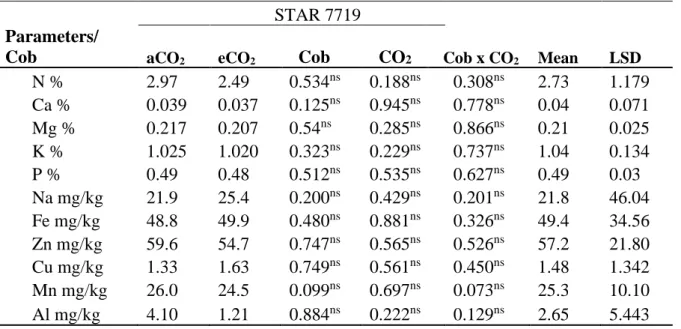
Introduction
113 phenolic concentrations in plants growing under eCO2 conditions, and such an increase in phenolics adversely affects plant-feeding insects (Hartley et al., 2000; Gao et al., 2008). The health benefits of green flours are not only related to essential nutrients such as carbohydrates, vitamins and minerals, but also related to phytochemicals such as phenolics that contribute to the nutritional composition of green flours (Adom and Liu, 2002; Smith et al., 2004). Therefore, current climate change could be beneficial in that it can improve crop productivity (Thomson et al., 2005) by simply removing greenhouse gases such as methane (CH4) and nitrous oxide (N2O) and fixing them in the soil with carbon sequestration.
It is regularly cultivated for fresh food or processed into preserves (Zhang et al., 2016). It has been estimated that more than 900 million people rely on maize as their staple food worldwide, especially in Latin America, Africa and Asia (Shiferaw et al., 2011). Elevated CO2 has strong effects on C4 plant metabolism and therefore food production of such crops (Berry and Björkman, 1980; Heckathorn et al.
Materials and Methods
Laboratory analysis
Two rows of fresh kernels placed in the center were removed from three flasks and 2.0 g was weighed out. The determination of TSS was achieved by weighing approx. 2 g of fresh kernels from the upper, middle and lower parts of fresh cob samples of the treatment and control. Five grams of fresh kernel was weighed out and cut into very small pieces, homogenized with a mortar and pestle and transferred to the centrifuge tubes.
The protein concentration of 0.5 mg/mL was chosen as the standard for determining the concentration of the unknown sample for protein in sweet corn kernels. The fruit parameters analyzed were: ascorbic acid, total carotenoids, total protein and total soluble solids (TSS). Differences in means for these phytochemicals were determined using Fisher's protected least significant difference test revealed significant difference at (p<0.05 and p<0.01).

Discussion
In addition, nitrogen immobilization in vegetative tissues (Luo et al., 2004), soils and reduced nitrate assimilation under eCO2 (Bloom et al., 2010). C4 crops have great potential to provide nutrients for human health (Jobe et al. 2020). Global climate change is the result of the accumulation of greenhouse gases (GHGs) in the atmosphere, together with the subsequent increase in temperature, which has caused changes in precipitation patterns (Forster et al., 2007; Vanaja et al., 2015).
Of these emissions, carbon dioxide (CO2) is considered the main culprit, with concentrations expected to reach 550 ppm by 2050 (IPCC, 2007), likely to affect crop production and agricultural crop productivity, ultimately impacting global food security (Vanaja et al., 2015). On the contrary, Dong et al. 2018) reported no significant increase in titratable acidity in root, stem, leaves and fruits. Our current findings on protein decrease are consistent with findings from Loladze (2014) and Zhu et al. 2018) who showed that while eCO2 increases plant growth and yield, product protein content tends to decrease due to a greater allocation of sugars at the expense of protein.
LI-670, Control Air Flow, USA
CR 1000-wirig panel, Data logger, Campbell Scientific, USA
SCE 210C093, Solenoid valve, Diya Valves International, RSA
Nature Mycelium CO 2 generator, Windell Hydroponics, co.za
Soil moisture percentage (%) in 10L pots in four-week intervals
Soil moisture percentage (%) in 10L pots
Analysis of variance for soil moisture percentage levels for sweetcorn grow
